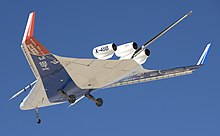
A jet engine is a type of reaction engine, discharging a fast-moving jet of heated gas that generates thrust by jet propulsion. While this broad definition may include rocket, water jet, and hybrid propulsion, the term jet engine typically refers to an internal combustion air-breathing jet engine such as a turbojet, turbofan, ramjet, pulse jet, or scramjet. In general, jet engines are internal combustion engines.

The turbofan or fanjet is a type of airbreathing jet engine that is widely used in aircraft propulsion. The word "turbofan" is a combination of the preceding generation engine technology of the turbojet, and a reference to the additional fan stage added. It consists of a gas turbine engine which achieves mechanical energy from combustion, and a ducted fan that uses the mechanical energy from the gas turbine to force air rearwards. Thus, whereas all the air taken in by a turbojet passes through the combustion chamber and turbines, in a turbofan some of that air bypasses these components. A turbofan thus can be thought of as a turbojet being used to drive a ducted fan, with both of these contributing to the thrust.

A supersonic transport (SST) or a supersonic airliner is a civilian supersonic aircraft designed to transport passengers at speeds greater than the speed of sound. To date, the only SSTs to see regular service have been Concorde and the Tupolev Tu-144. The last passenger flight of the Tu-144 was in June 1978 and it was last flown in 1999 by NASA. Concorde's last commercial flight was in October 2003, with a November 26, 2003 ferry flight being its last airborne operation. Following the permanent cessation of flying by Concorde, there are no remaining SSTs in commercial service. Several companies have each proposed a supersonic business jet, which may bring supersonic transport back again.
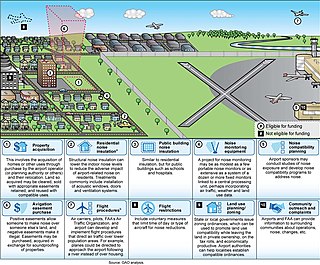
Environmental noise is an accumulation of noise pollution that occurs outside. This noise can be caused by transport, industrial, and recreational activities.
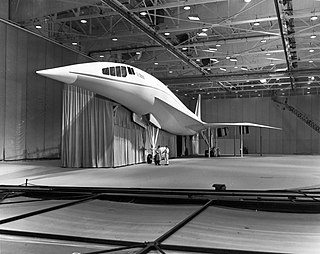
The Lockheed L-2000 was Lockheed Corporation's entry in a government-funded competition to build the United States' first supersonic airliner in the 1960s. The L-2000 lost the contract to the Boeing 2707, but that competing design was ultimately canceled for political, environmental and economic reasons.

The General Electric GE90 is a family of high-bypass turbofan aircraft engines built by GE Aviation for the Boeing 777, with thrust ratings from 81,000 to 115,000 pounds-force. It entered service with British Airways in November 1995. It is one of three options for the 777-200, -200ER, and -300 versions, and the exclusive engine of the -200LR, -300ER, and 777F. It was the largest jet engine, until being surpassed in January 2020 by its successor, the 110,000 lbf (490 kN) GE9X, which has a 6-inch (15 cm) larger diameter fan. However, the GE90-115B, the most recent variant, is rated for a higher thrust than the GE9X.
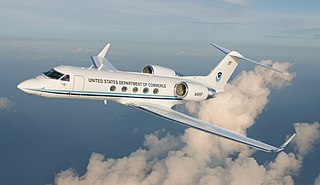
The Gulfstream IV and derivatives are a famous family of twinjet aircraft, mainly for private or business use. They were designed and built by Gulfstream Aerospace, a General Dynamics company based in Savannah, Georgia, United States, from 1985 until 2018. Aircraft power is provided by two Rolls-Royce RB.183 Tay turbofans.

A propfan, also called an open rotor engine, open fan engine or unducted fan, is a type of aircraft engine related in concept to both the turboprop and turbofan, but distinct from both. The design is intended to offer the speed and performance of a turbofan, with the fuel economy of a turboprop. A propfan is typically designed with a large number of short, highly twisted blades, similar to the (ducted) fan in a turbofan engine. For this reason, the propfan has been variously described as an "unducted fan" (UDF) or an "ultra-high-bypass (UHB) turbofan".

A hush kit is an aerodynamic device used to help reduce the noise produced by older aircraft jet engines. These devices are typically installed on older turbojet and low-bypass turbofan engines, as they are much louder than later high-bypass turbofan engines.

Noise control or noise mitigation is a set of strategies to reduce noise pollution or to reduce the impact of that noise, whether outdoors or indoors.

The Learjet 24 is an American six-to-eight-seat twin-engine, high-speed business jet, which was manufactured by Learjet as the successor to the Learjet 23.

The geared turbofan is a type of turbofan aircraft engine with a planetary gearbox between the low pressure compressor / turbine and the fan, enabling each to spin at its optimum speed. The benefit of the design is lower fuel consumption and much quieter operation. The drawback is that it increases weight and adds complexity.

The Cessna CitationJet/CJ/M2 are a series of light business jets built by Cessna, and are part of the Citation family. Launched in October 1989, the first flight of the Model 525 was on April 29, 1991. Federal Aviation Administration (FAA) certification was awarded on October 16, 1992, and the first aircraft was delivered on March 30, 1993. The CJ series are powered by two Williams FJ44 engines; the design uses the Citation II's forward fuselage with a new carry-through section wing and a T-tail. The original CitationJet model has been updated into the CJ1/CJ1+/M2 variants; additionally, the CJ1 was stretched into the CJ2/CJ2+ which was built between 2000 and 2016. The design was then further developed into the CJ3/CJ3+, built from December 2004 to present, and finally into the CJ4 which has been built since 2010. By June 2017, 2,000 of all variants had been delivered.

The Pratt & Whitney PW1000G, also called the GTF, is a high-bypass geared turbofan engine family produced by Pratt & Whitney. After many demonstrators, the program was launched with the PW1200G on the Mitsubishi SpaceJet in March 2008, first flight tested in July 2008. The first variant to be certified was the PW1500G for the Airbus A220 in February 2013. The program cost is estimated at $10 billion.

The Gulfstream G650 is a large business jet produced by Gulfstream Aerospace. The model is designated Gulfstream GVI in its type certificate. The aircraft can be configured to carry from 11 to 18 passengers over a range of 7,000 nautical miles [nmi] at a top speed of Mach 0.925. The aircraft is powered by two Rolls-Royce BR725 turbofans, mounted on the rear fuselage. Gulfstream began the G650 program in 2005 and revealed it to the public in 2008. The G650ER is an extended-range version of the G650, adding about 500 nmi by modifying the fuel system, an upgrade offered for existing G650 aircraft.
An airbreathing jet engine is a jet engine in which the exhaust gas which supplies jet propulsion is atmospheric air, which is taken in, compressed, heated, and expanded back to atmospheric pressure through a propelling nozzle. Compression may be provided by a gas turbine, as in the original turbojet and newer turbofan, or arise solely from the ram pressure of the vehicle's velocity, as with the ramjet and pulsejet.

The General Electric Passport is a turbofan developed by GE Aerospace for large business jets. It was selected in 2010 to power the Bombardier Global 7500 and 8000, first run on June 24, 2013, and first flown in 2015. It was certified in April 2016 and powered the Global 7500 first flight on November 4, 2016, before its 2018 introduction. It produces 14,000 to 20,000 lbf of thrust, a range previously covered by the General Electric CF34. A smaller scaled CFM LEAP, it is a twin-spool axial engine with a 5.6:1 bypass ratio and a 45:1 overall pressure ratio and is noted for its large one-piece 52 in (130 cm) fan 18-blade titanium blisk.

The Hawker Siddeley HS.141 was a 1970s design study and submission for a British V/STOL airliner requirement. Designed by Hawker Siddeley Aviation and tested in wind tunnels neither prototypes nor production aircraft were produced.
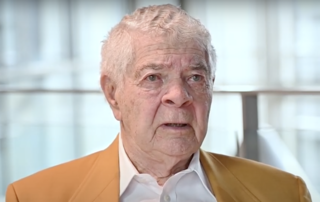
James David Raisbeck was an American aeronautical engineer, known for his entrepreneurship in developing products which enhance the performance of production aircraft.

The General Electric Affinity was a turbofan developed by GE Aviation for supersonic transports. Conceived in May 2017 to power the Aerion AS2 supersonic business jet, initial design was completed in 2018 and detailed design in 2020 for the first prototype production. GE Aviation discontinued development of the engine in May 2021. Its high-pressure core is derived from the CFM56, matched to a new twin fan low-pressure section for a reduced bypass ratio better suited to supersonic flight.









